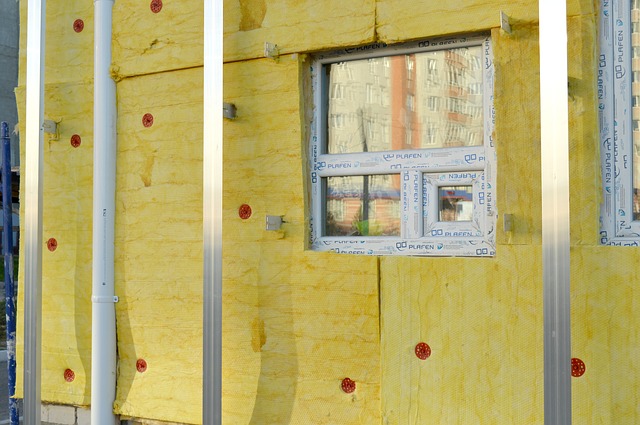Mineral wool
Mineral wool is a wide-ranging term which describes fibrous, spun yarn materials used as insulation in construction and other sectors. Depending on the mineral used and the process employed, it also goes by names, such as glass wool, stone wool, slag wool, mineral fibre (or fiber), mineral cotton, man-made vitreous fibre and man-made mineral fibre.
Although first produced commercially in 1871 in Osnabruck, Germany, the rock wool insulation industry was initiated in the US in 1897 when Charles Hall was able to convert molten rock into fibres.
Mineral wool applications in construction include:
- As thermal insulation: in masonry cavity-walls, timber frame construction, and for roof spaces, also, in stud-partition walls and flat roofs, as well as for pipework and ductwork.
- As acoustic insulation to resist the transmission of sound through partition walls and storey floors.
- As fire insulation.
- To absorb water and air to help root growth and nutrient uptake in hydroponics – ie, growing plants without soil using only solutions and minerals.
Properties:
- Because it is porous with an open fibre structure, mineral wool traps air, making it highly efficient as an insulation material. A representative lambda (λ) value for it would be around 0.03W-0.04/mK.
- The wool’s porous nature also makes it a good noise absorber. It is also incombustible and does not fuel the spread of flame.
- Mineral wool is not prone to thermal ageing, which means it can retain its insulating properties for as long as it is in service.
- Mineral wool does not sustain vermin and is highly resistant to the growth of mould, fungi or bacteria.
- Glass and rock mineral wool insulation may be completely non-combustible (Euroclass A1 fire rating (non-combustible material’)) and can slow the spread of flame – this can allow a building’s occupants extra time to escape.
- Mineral wool also has low thermal conductivity and resists the passage of sound. It is highly resistant to expansion and shrinkage which results in joints that stay as close as possible. It is also relatively inexpensive
The two main variants of mineral wool are stone wool and glass wool.
Glass wool is typically, manufactured by spinning or drawing a yarn of melted glass; a binder is used to form the glass fibres into a wool-type consistency. It can be produced as rolls, slabs, applied in-situ or sprayed.
Rock or stone wool is made from molten rock materials (such as ceramics or slag cast-offs – a by-product of the smelting process). It is made by blowing a stream of air through molten rock at a temperature of around 1,600°C. The result is very fine strands which are combined to create a wool-type material; alternatively, stone wool can be made by a process analogous to that of making candy floss – the molten rock is spun at high speeds and the threads drawn off. Typically, they will have a diameter in the range of 2-6 microns (millionths of a metre). They are then amalgamated to produce the characteristic woolly structure which can be compressed into boards, mineral wool batts or other forms. In its loose form, the wool can be blown into cavity walls and roof void spaces.
Illustrated Guide to Mechanical Building Services 3rd Edition (BG 31/2017), written by David Bleicher and published by BSRIA in May 2017, suggests that mineral wool is: ‘A soft insulation made from drawn glass or rock fibres. It is commonly used on hot water and heating services. In slab form it is also used to insulate ductwork, and is often used as an acoustic insulation around drainage. The insulating properties of mineral wool are reduced when it gets wet, so it should not be used in locations where this might happen, for example outdoors. If used on cold water, chilled water or refrigeration pipework, it must be vapour sealed to reduce the risk of condensation forming on the pipe surface.’
[edit] Related articles on Designing Buildings
- Acoustic insulation
- Cavity wall insulation
- Designing out unintended consequences when applying solid wall insulation FB 79
- External wall insulation
- Floor insulation
- Insulation for ground floors
- Mineral.
- Reducing thermal bridging at junctions when designing and installing solid wall insulation FB 61
- Roof insulation
- Solid wall insulation
- Solid Wall Insulation: Unlocking demand and driving up standards
- Sound insulation in buildings
- Specifying insulation for inverted roofs
- Thermal insulation for buildings
- Types of insulation
- Understanding Insulation and the Part It Plays in Building Regulations
- Wall insulation and moisture risk
Featured articles and news
Infrastructure that connect the physical and digital domains.
Harnessing robotics and AI in challenging environments
The key to nuclear decommissioning and fusion engineering.
BSRIA announces Lisa Ashworth as new CEO
Tasked with furthering BSRIA’s impressive growth ambitions.
Public buildings get half a million energy efficiency boost
£557 million to switch to cleaner heating and save on energy.
CIOB launches pre-election manifesto
Outlining potential future policies for the next government.
Grenfell Tower Inquiry announcement
Phase 2 hearings come to a close and the final report due in September.
Progress from Parts L, F and O: A whitepaper, one year on.
A replicated study to understand the opinion of practitioners.
ECA announces new president 2024
Electrical engineer and business leader Stuart Smith.
A distinct type of countryside that should be celebrated.
Should Part O be extended to existing buildings?
EAC brands heatwave adaptation a missed opportunity.
Definition of Statutory in workplace and facilities management
Established by IWFM, BESA, CIBSE and BSRIA.
Tackling the transition from traditional heating systems
59% lack the necessary information and confidence to switch.
The general election and the construction industry
As PM, Rishi Sunak announces July 4 date for an election.
Eco apprenticeships continue help grow green workforce
A year after being recognised at the King's coronation.
Permitted development rights for agricultural buildings
The changes coming into effect as of May 21, 2024.






















